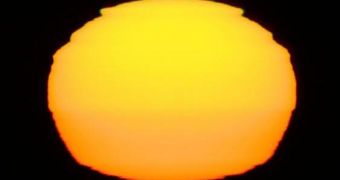Ideal atmospheric conditions are often required during astronomical observations, since Earth's atmosphere has a distorting effect on the light traveling through it. In fact, the air in the atmosphere acts as a giant prism thus dispersing and decomposing light into its basic wavelengths, also known as 'colors'. In conditions such as those present at the Cerro Paranal site, where the atmosphere presents minimal interference with light and where ESO's Very Large Telescope lies, phenomena such as green and blue flashes of light and Gegenschein can be routinely observed by the Paranal staff during the sunset.
Because the VLT is 2635 meters atop a mountain in the Chilean Atacama Desert, the atmosphere is extremely stable and presents an unobstructed view of the sunset, which enables the view of green and blue flashes. In fact, the Paranal site has more than 300 days of cloudless sky every year, allowing maximum observation time for the world's most advanced optical telescope.
"The most challenging is to capture the green flash while still seeing the rest of the Sun with all its colors", says Stephane Guisard, part of the ESO staff stationed at the Paranal site. It is somewhat of a tradition that before a long night of observation the entire staff from the VLT should participate in watching the sunset. One of those regularly following tradition is Guillaume Blanchard who, at Christmas Eve, captured a picture of the Sun setting with a blue flash by using his hobby telescope.
Another incredible phenomenon that can be seen from the Paranal site is the 'Gegenschein', counter shine in German, closely watched by ESO astronomer Yuri Beletsky. This phenomenon that can be viewed only during night time, also known as the Zodiacal light, is a reflection of light coming from the interplanetary dust in the Solar System's ecliptic. Most of the time light pollution doesn't allow the possibility of viewing even some of the brightest stars on the night sky, thus because Gegenschein is so faint it can only be observed from locations far away from major cities or areas with high light pollution.
The Zodiacal light is in fact the light reflected by the interplanetary dust near the Sun, while Gegenschein only occurs in an area opposite to the Sun. Interplanetary dust is a leftover from the creation of the Solar System and debris left behind by the passing of comets and asteroids through the vicinity of the Sun. Each particle in the dust cloud reflects light much as the Moon does.
"If you could see the individual dust particles then you would see the ones in the middle of the Gegenschein looking like very tiny full moons, while the ones hidden in the faint part of the dust band would look like tiny crescent moons. But even the VLT cannot see such tiny individual dust particles out in space. Instead we see the combined effect, in the photons like these, of millions of tiny dust particles reflecting light back to us from the Sun", said ESO astronomer Colin Snodgrass.

 14 DAY TRIAL //
14 DAY TRIAL //